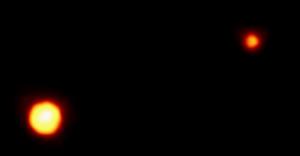Post
Forever Alone
29 September 2013
 R. Albrecht, ESA/ESO Space Telescope European Coordinating Facility; NASA
R. Albrecht, ESA/ESO Space Telescope European Coordinating Facility; NASAA plutino is an asteroid-sized body that orbits the Sun in a 2:3 resonance with Neptune. They are named after Pluto, which also orbits the Sun twice for every three orbits of Neptune. It is thought that Pluto and the other plutinos were clustered into this resonance during the migration of the outer planets during the early solar system.
We know from observing several exoplanetary systems that large planets are often close to their star. This agrees with computer models that indicate larger planets will tend to drift inward toward their star due to drag during the accretion stage of the solar system. But in our solar system the large planets are all outer planets, which is unusual. It’s generally thought that orbital resonances caused the large planets to move outward.
The most popular model, known as the Nice (pronounced neese) model, posits that Jupiter was roughly at its current distance when it entered a 1:2 resonance with Saturn. The resulting resonance drove Neptune (initially closer than Uranus) to the outer edge of the solar system, and pushed pushed Uranus and Saturn outward to their current positions. Because of this shift in the large planets, some smaller objects such as Pluto were pushed into a resonance with Neptune, becoming the plutinos.
One interesting aspect of plutinos is that binary plutinos are rare. Pluto, which is Charon companion (seen above) is one of the exceptions, but then Pluto is the largest plutino. One other binary plutino was discovered in 2012. This is in contrast to the asteroid belt and the outer Kuiper belt, where binary objects are more common. So what is it about plutinos that makes binaries rare?
It has been thought that perhaps some effect of their original clustering might be the reason, but now a new paper in Astronomy and Astrophysics shows that it might be the 2:3 resonance itself that is the cause.1
The authors ran computer simulations of 4-body models. That is, they put the Sun and Neptune in their current position, then ran models with different binary bodies in plutino orbits. What they found is the 2:3 resonance tends to gradually increase the eccentricity of the binaries orbits to the point where they become unstable. The resonance also makes it difficult to form binary systems for the same reason.
If this model is correct, then not only would binary plutinos be rare (just as we observe), but the binary plutinos that do exist would be older binaries brought into 2:3 resonance after Neptune had reached its current orbit.
This is just one model, and a rather simple one at that. It will take more computational analysis to see if the model is robust. But if it holds up it would explain why most plutinos are forever alone.
Compère, A., et al. “A possible mechanism to explain the lack of binary asteroids among the Plutinos.” Astronomy & Astrophysics 558 (2013): A4. ↩︎